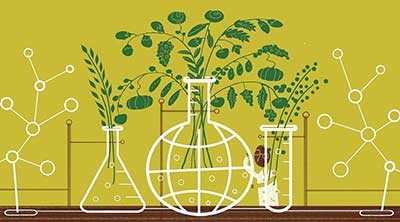Date: 17/10/2022
Relevance: GS-3: Indian Economy and issues relating to planning, mobilization of resources, growth, development, and employment. Inclusive growth and issues arising from it.
Key Phrases: World Food Day, Food And Agriculture Organisation, Climate Adaptation Strategies, Climate Resilience, Two-Way Feedback Mechanisms
Why in News?
- October 16 is celebrated as World Food Day around the world which is the foundation day of the Food and Agriculture Organisation (FAO) of the United Nations which was set up in 1945.
- It was established post World War II with a global vision to ensure that enough food is produced to feed the increasing population.
Key Highlights:
- There are almost 8 billion people on this planet, and there is ample food to feed them if they have the money to buy it.
- Access to food at affordable prices, however, remains a challenge for a substantial segment of humanity which leads to malnutrition.
- A convergence of issues including climate change, population growth, energy supply and water scarcity are putting pressure on global food systems on a scale previously unencountered.
- Agricultural science and technology needs to be targeted towards providing solutions to these issues threatening global food security.
Role of science and innovations in ensuring food security:
- The success of science and innovations in the agri-food space has been able to produce so much food that the entire global population can be fed.
- Countries that are guided by scientific knowledge and the spirit of innovation, instead of ideologies and dogmas, have produced ample food, even in deserts, for example, Israel.
- The technological breakthrough in high-yielding varieties (HYV) of wheat by Normal Borlaug and his team and Henry Beachell and Gurdev Khush in rice at IRRI, ensured that humanity can have plenty of the basic staples.
Do you know?
- Normal Borlaug received the Nobel Prize for peace in 1970, as there is no Nobel Prize for Agriculture, for saving millions of lives through scientific research.
- He envisioned setting up the World Food Prize, somewhat equivalent to the Nobel Prize for Agriculture.
- It was established in 1986 and is given every year on October 16 in a special ceremony in Des Moines, Iowa.
- Indians including M S Swaminathan, Verghese Kurien, Gurdev Khush and Rattan Lal have been recipients of the prize.
- The focus has now shifted from just augmenting food production to nutrition and climate resilience.
- This year’s award went to Cynthia Rosenzweig for her pioneering work in modeling the impact of climate change on food production.
Need for climate adaptation strategies as well as mitigating emissions from agriculture:
- The climate shocks are increasing across the world with higher frequency and intensity of heat waves, droughts, and untimely floods, putting millions at risk of food security.
- While agriculture gets severely impacted by climate change, it also leads to almost 28 percent of the global greenhouse gas (GHG) emissions thus contributing to global warming.
- Thus, it is time to invest not only in climate adaptation strategies but also re-work our policies that can mitigate GHG emissions for agriculture.
What should be the way ahead?
- The net zero carbon target which seems to be too ambitious can serve humanity well if sincerely implemented and this planet can still feed more than 10 billion people.
- For this, the behaviour of people needs to be changed towards their way of doing things be it in agriculture or in any other field.
- One has to work on policies that incentivise people to change their way of doing things,
- Today, there seems to be a lack of sync between policies and technologies.
- It is high time for India to wake up, and double or even triple its expenditure on agri-research and development and education.
- Currently, it hovers around 0.6 percent of the agri-GDP for the Centre and states combined.
- This needs to go up to at least 1 per cent, and, preferably between 1.5 to 2 percent of the agri-GDP.
- Research should include the development of new crop varieties that are resistant to the effects of climate change, and diseases, and contribute to higher yields at the same time.
- Farmers and scientists need to communicate via two-way feedback mechanisms, so that science can be directed to the needs of the producer and the market.
- Improving communication and links along the agricultural supply chain can help foster sustainable food production.
Conclusion:
- It is high time that the best is given to this planet, as well as people’s basic needs for food, are catered to.
- There is a pressing need for governments and policy-makers to drive a transition toward sustainable agriculture and prioritize the reduction of food loss and waste in their climate change action plans.
- Only then India can be self-reliant (atmanirbhar) in food even in the face of adverse climate change.
Source: Indian Express
Mains Question:
Q. Discuss the role of science and innovations in ensuring food security and the need for climate adaptation strategies as well as mitigating emissions from agriculture. (150 words).








